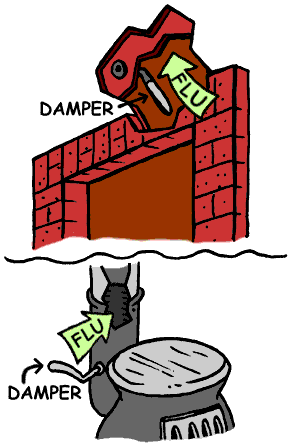Introduction
The latter paper is an instruction manual on how to light a fire in a fireplace. This article is intended for persons living in houses with fireplaces during winter. Additionally, it is intended for holiday makers who are susceptible to cold temperatures. These audience members can be any age above sixteen.
The procedure
Before lighting a fire successfully, the following apparatus are needed:
- Sheets of paper (preferably newspapers – 5-7 pieces)
- Dry kindling (2-3 handfuls each ½ inches wide and to 12 inches long)
- Logs of firewood (5-7)- must be seasoned and split
- Butane lighter or a long match
- Leather (fireproof) gloves)
- Fireplace screen
- Optional – fatwood kindling 3-4 pieces
- Optional – fireplace tools like a broom, tongs, a shovel and a poker
The following is definition of terms that will be used in subsequent explanations. The flue is that passage of air in the chimney as seen in the top section of the diagram below. The damper is a chimney opening (outlet) that allows air to enter or leave the fire. It is opened or closed using a lever system with chains or a cable. The draft is air that moves in the fireplace to sustain the fire. Kindling is any material that initially spreads the fire. It is normally made up of softwood from softwood trees or may be commercially made. The commercial kindling is called fatwood and is typically composed of pine tree remains that have been cut into easy to use sizes. A fire grate is typically an elevated portion in the middle of the fireplace in which sheets of paper are placed. It ensures that the kindling is well ventilated with air by pulling the duct.

Before one can successfully light a fire it imperative to ensure that the following steps are carried out: First, one must familiarize oneself with the operations of the damper because some dampers are located in the bottom section of the chimney while others are located at the top. Chains should be altered to ensure that the damper is halfway open. Firewood should be selected from a series of hardwood tress such as oak or maple. This type of wood needs to have dried sufficiently since freshly cut wood is usually too wet. Chestnut trees should be avoided as they crackle too much and may spread fire outside the fireplace. Hardwood is usually larger than softwood (as indicated in the apparatus section of the paper). The fireplace must be at room temperature so it would help to close the damper prior to setting up the fire.
To start the fire, one must crumple the newspapers and place them at the fire grate. Shortly after, the kindling should be placed in a pyramid pattern on top of the newspapers (In order to leave more ventilation). Shortly after, small hardwood should be added on top of the kindling. Other pieces of firewood will be inserted after the fire has already been established
To light the fire, two opposite ends of the newspaper heap should be lit or the middle section first. Lighting can be done by a butane burner or a matchstick. After ten minutes, the kindling will eventually catch fire and will then spread to the hardwood in ten minutes time. More hardwood pieces should be added as the fire progresses. For more heat, the flue should be adjusted accordingly. In order to ensure smooth flue flow, other sheets of paper should be lit above the pile of firewood at the top of the fireplace so as to warm that air. Hardwood can be staked up to two thirds of the height of the fire. In order to stop the fire, one should stop adding more wood. After ten hours, the fire will die out. When grey ash has formed and there is no more heat, then it should be scooped out with a shovel and tongs. Metal gloves are essential in this process. The ashes can be taken to a composite area in the house compound.
A number of safety precautions need to be adhered to while making the fire. First of all, no flammable materials should be placed anywhere near the fire. Fire screens should be enabled after the fire has been established. Magazines and colored paper should be avoided when starting the fire as these emit harmful material. The chimney should be checked and cleaned in order to avoid accumulation of creosote which can lead to a chimney fire. No plastics or oil should be placed in the fire as these are toxic in nature. To avoid too much smoke in the house, the draft should be working properly.
Conclusion
Lighting a fire in a fireplace is a simple process when all the materials have been gathered in the right quantities, placed at the right time and monitored accordingly.
References
Learn2 Corporation. Learn to make a fire in a fireplace. 2009. Web.